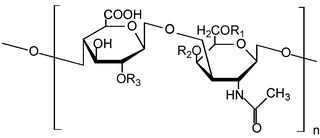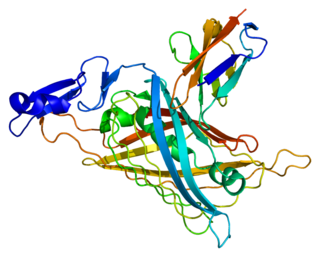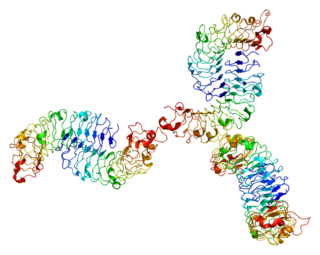Lumican, [5] also known as LUM, is an extracellular matrix protein that, in humans, is encoded by the LUM gene on chromosome 12. [6] [7]
Lumican, [5] also known as LUM, is an extracellular matrix protein that, in humans, is encoded by the LUM gene on chromosome 12. [6] [7]
Lumican is a proteoglycan Class II member of the small leucine-rich proteoglycan (SLRP) family that includes decorin, biglycan, fibromodulin, keratocan, epiphycan, and osteoglycin. [8]
Like the other SLRPs, lumican has a molecular weight of about 40 kilodaltons and has four major intramolecular domains: [9]
There are four N-linked sites within the leucine-rich repeat domain of the protein core that can be substituted with keratan sulfate. The core protein of lumican (like decorin and fibromodulin) is horseshoe shaped. This enables it bind to collagen molecules within a collagen fibril, thus helping keep adjacent fibrils apart. [10]
Lumican is a major keratan sulfate proteoglycan of the cornea but is ubiquitously distributed in most mesenchymal tissues throughout the body. [11] Lumican is involved in collagen fibril organization and circumferential growth, corneal transparency, and epithelial cell migration and tissue repair. [6] Corneal transparency is possible due to the exact alignment of collagen fibers by lumican (and keratocan) in the intrafibrillar space.
Mice that have the lumican gene knocked out (Lum-/-) develop opacities of the cornea in both eyes and fragile skin. [12] The lumican (LUM) gene was thought to be a candidate susceptibility gene for high myopia; however, a meta-analysis showed no association between LUM polymorphism and high myopia susceptibility in all genetic models studied. [13]
Lum knockout mice also have abnormal collagen in their heart tissue, with fewer and thicker fibrils. [14] Mice deficient in both lumican and fibromodulin develop severe tendinopathy (tendon pathology), revealing the importance of these SLRPs in the development of correctly sized and aligned collagen fibers in tendon. [15] Along with other extracellular matrix components, lumican expression was increased in equine flexor tendons six weeks after an injury. [16]
Lumican is present in the extracellular matrix of uteral tissues in fertile women. [17] There is an increase of lumican during the proliferative to secretory phase of the endometrium. In menopausal endometrial tissue, the level of lumican expression decreases and is also low in pathological compared to normal endometrium.
Lumican is highly expressed in pleural effusions (lung fluid) of patients with adenocarcinoma. [18] Its expression was low in cancer cells but high in the extracellular matrix surrounding the tumor. Lumican expression was not associated with tumor grade or stage. In about half the patients with pancreatic ductal adenocarcinoma tested, [19] lumican in the extracellular matrix around the tumor was associated with a reduction in metastatic recurrence after surgery and with a three-fold longer survival than patients without stromal lumican. As lumican can directly bind to and inhibit matrix metalloproteinase-14 (MMP14), lumican may limit tumor progression by preventing extracellular matrix collagen proteolysis by this enzyme. [20]

A tendon or sinew is a tough band of dense fibrous connective tissue that connects muscle to bone. It sends the mechanical forces of muscle contraction to the skeletal system, while withstanding tension.

Fibronectin is a high-molecular weight glycoprotein of the extracellular matrix that binds to membrane-spanning receptor proteins called integrins. It is approved for marketing as a topical solution in India by Central Drugs Standard Control organization in 2020 under the brand name FIBREGA for chronic wounds. Fibronectin also binds to other extracellular matrix proteins such as collagen, fibrin, and heparan sulfate proteoglycans.

In biology, the extracellular matrix (ECM), is a network consisting of extracellular macromolecules and minerals, such as collagen, enzymes, glycoproteins and hydroxyapatite that provide structural and biochemical support to surrounding cells. Because multicellularity evolved independently in different multicellular lineages, the composition of ECM varies between multicellular structures; however, cell adhesion, cell-to-cell communication and differentiation are common functions of the ECM.

Proteoglycans are proteins that are heavily glycosylated. The basic proteoglycan unit consists of a "core protein" with one or more covalently attached glycosaminoglycan (GAG) chain(s). The point of attachment is a serine (Ser) residue to which the glycosaminoglycan is joined through a tetrasaccharide bridge. The Ser residue is generally in the sequence -Ser-Gly-X-Gly-, although not every protein with this sequence has an attached glycosaminoglycan. The chains are long, linear carbohydrate polymers that are negatively charged under physiological conditions due to the occurrence of sulfate and uronic acid groups. Proteoglycans occur in connective tissue.

Glycosaminoglycans (GAGs) or mucopolysaccharides are long, linear polysaccharides consisting of repeating disaccharide units. The repeating two-sugar unit consists of a uronic sugar and an amino sugar, except in the case of the sulfated glycosaminoglycan keratan, where, in place of the uronic sugar there is a galactose unit. GAGs are found in vertebrates, invertebrates and bacteria. Because GAGs are highly polar molecules and attract water; the body uses them as lubricants or shock absorbers.

Chondroblasts, or perichondrial cells, is the name given to mesenchymal progenitor cells in situ which, from endochondral ossification, will form chondrocytes in the growing cartilage matrix. Another name for them is subchondral cortico-spongious progenitors. They have euchromatic nuclei and stain by basic dyes.

Keratan sulfate (KS), also called keratosulfate, is any of several sulfated glycosaminoglycans that have been found especially in the cornea, cartilage, and bone. It is also synthesized in the central nervous system where it participates both in development and in the glial scar formation following an injury. Keratan sulfates are large, highly hydrated molecules which in joints can act as a cushion to absorb mechanical shock.

Perlecan (PLC) also known as basement membrane-specific heparan sulfate proteoglycan core protein (HSPG) or heparan sulfate proteoglycan 2 (HSPG2), is a protein that in humans is encoded by the HSPG2 gene. The HSPG2 gene codes for a 4,391 amino acid protein with a molecular weight of 468,829. It is one of the largest known proteins. The name perlecan comes from its appearance as a "string of pearls" in rotary shadowed images.

The stroma of the cornea is a fibrous, tough, unyielding, perfectly transparent and the thickest layer of the cornea of the eye. It is between Bowman's layer anteriorly, and Descemet's membrane posteriorly.

Decorin is a protein that in humans is encoded by the DCN gene.

Biglycan is a small leucine-rich repeat proteoglycan (SLRP) which is found in a variety of extracellular matrix tissues, including bone, cartilage and tendon. In humans, biglycan is encoded by the BGN gene which is located on the X chromosome.
FACIT collagen is a type of collagen and also a proteoglycan that have two or more triple-helical domains that connect to collagen fibrils and share protein domains with non-collagen matrix molecules. FACIT collagens derive their name from their association and interaction with fibrillar collagens. Unlike fibrillar collagens, which form long fibers.

Collagen alpha-6(IV) chain is a protein that in humans is encoded by the COL4A6 gene.

Osteoglycin, encoded by the OGN gene, is a human protein.

Collagen alpha-1(XIV) chain is a protein that in humans is encoded by the COL14A1 gene. It likely plays a role in collagen binding and cell-cell adhesion.

Collagen alpha-1(XII) chain is a protein that in humans is encoded by the COL12A1 gene.

Keratocan (KTN) also known as keratan sulfate proteoglycan keratocan, is a protein that in humans is encoded by the KERA gene.

Fibromodulin is a protein that in humans is encoded by the FMOD gene.

Osteomodulin is a protein that in humans is encoded by the OMD gene.

Dermatopontin also known as tyrosine-rich acidic matrix protein (TRAMP) is a protein that in humans is encoded by the DPT gene. Dermatopontin is a 22-kDa protein of the noncollagenous extracellular matrix (ECM) estimated to comprise 12 mg/kg of wet dermis weight. To date, homologues have been identified in five different mammals and 12 different invertebrates with multiple functions. In vertebrates, the primary function of dermatopontin is a structural component of the ECM, cell adhesion, modulation of TGF-β activity and cellular quiescence). It also has pathological involvement in heart attacks and decreased expression in leiomyoma and fibrosis. In invertebrate, dermatopontin homologue plays a role in hemagglutination, cell-cell aggregation, and expression during parasite infection.